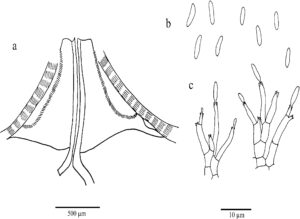Amphiporthe Petr., Sydowia 24(1-6): 257 (1971)
= Amphicytostroma Petr., Ann Mycol. 19(1/2): 63 (1921)
MycoBank number: MB 169; Index Fungorum number: IF 169; Facesoffungi number: FoF 4410; 3 morphological species (Species Fungorum 2020), 2 species with sequence data and molecular data available for an unnamed species.
Saprobic on the host plant in terrestrial habitat. Sexual morph: see Petrak (1970) and Senanayake et al. (2018). Asexual morph: Conidiomata stromatic, produced in association with the sexual morph, the locules of which are basal with long ostiolar channels; the stroma subperidermal, periclinal, completely surrounding the ostiolar channels but not extending as deeply as the locules, multilocular but not convoluted, glabrous. Ostiole absent, dehiscence by the breakdown of the periderm near the apex of the ascocarp ostioles. Conidiomatal wall composed of pale brown, dense tissue of textura intricata at the base, becoming very diffuse, with little structural organization at the overlapping tissue, which mainly consists of sterile flexuous hyphae formed from very pale brown loose pseudoparenchyma. Conidiophores formed from the basal region of the locular wall, hyaline, filiform, branched, septate, smooth-walled. Conidiogenous cells hyaline, enteroblastic, phialidic, cylindrical, integrated or discrete, determinate, smooth-walled, periclinal wall thickened towards the apex. Conidia hyaline, cylindrical, straight or slightly curved, unicellular, smooth-walled, eguttulate (Sutton 1980).
Type species – Amphiporthe hranicensis (Petr.) Petr. (= Amphicytostroma tiliae (Sacc.) Petr., Ann Mycol. 19(1/2): 63 (1921))
Notes – Amphiporthe is one of the well-developed stromatic genera in Gnomoniaceae, which currently comprises three species (Senanayake et al. 2018). However, only A. hranicensis and A. raveneliana (Thüm. & Rehm) M.E. Barr have molecular data. Amphicytostroma tiliae (Sacc.) Petr. (type of Amphicytostroma) was considered to be the asexual morph of Amphiporthe hranicensis (Petrak 1921, Sutton 1980). Rossman et al. (2015a) reduced Amphicytostroma to a synonym of Amphiporthe since the latter is a widely used name. Amphiporthe tiliae (Sacc.) Rossman & Castl. was introduced for A. hranicensis (= Diaporthe hranicensis Petr.) and Amphicytostroma tiliae (= Cytospora tiliae Sacc.) (Rossman et al. 2015a). This concept was followed by Wijayawardene et al. (2017b). To avoid confusion with the generic name Amphiporthe, we recommend using the old name A. hranicensis rather than A. tiliae (the new combination taxa). Two species are included in Amphiporthe, i.e., A. hranicensis and A. raveneliana (Thüm. & Rehm) M.E. Barr. Sogonov et al. (2008) and Senanayake et al. (2017, 2018) showed that A. hranicensis belongs to Gnomoniaceae, but fresh collections and molecular data for the asexual morph of A. hranicensis are needed to confirm this connection.
Distribution – Czech Republic, Germany, UK (Sutton 1980; Senanayake et al. 2018).
Fig. 1 – Amphiporthe hranicensis (asexual morph, redrawn from Sutton 1980). a Vertical section of conidioma. b Conidia. c Conidiophores, conidiogenous cells and developing conidia.

Species
Amphiporthe hranicensis
